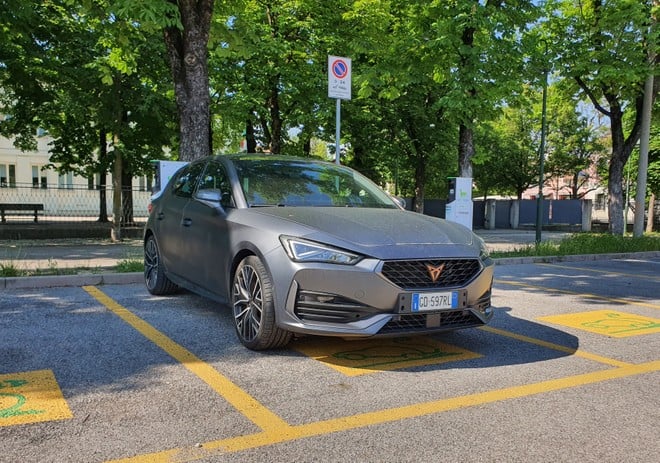
Cupra continues to grow rapidly. If in 2018 the Spanish brand had sold 14,350 cars, in 2022 it is; reached 152,900 deliveries, equal to an increase of 92.7% compared to the previous year (79,300 cars). A success also due to the constant expansion of the range with models that are achieving good market success.
Among these is; the Cupra Leon, a car that has the customer with age; average plus youth in Italy: 34 years. Available in both hatchback and station wagon (Sportstourer) versions, it is; proposal with unit; petrol, diesel and plug-ins. We therefore got to be able to drive the Cupra Leon for about a week, covering over 600 km, just enough to get a better idea of what it is. details of its characteristics and evaluate consumption.
Since we drove the 245 HP Plug-in model, it is It was also an opportunity to learn more about the operation of the car in electric only and to understand what happens on the consumption side when the battery is empty. download.
- DESIGN AND INTERIORS
- INFOTAINMENT
- AND THE CHILD SEAT?
- ENGINE AND SAFETY
- ROAD TEST
- ELECTRIC RANGE AND CONSUMPTION
- TECHNICAL SPECIFICATIONS
- PRICES

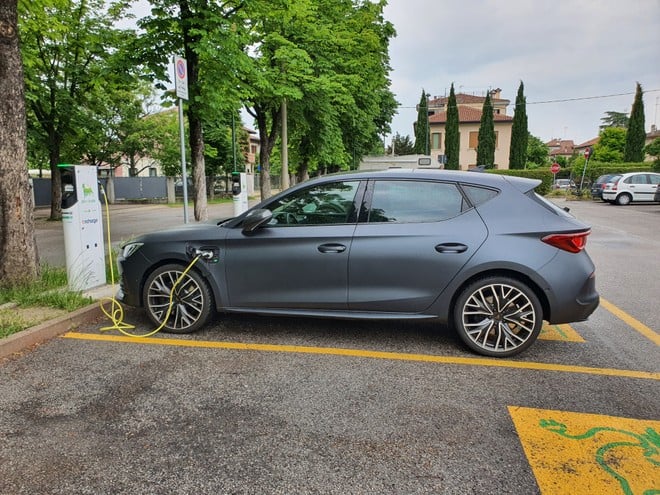
Cupra Leon measures 4,398 mm long x 1,799 mm wide x 1,467 mm high, with a wheelbase of 2,682 mm. Due to the presence of the battery, the capacity is limited. of the boot is reduced to 270 litres. The weight in running order & egrave; of 1,660 kg.
The car can; counting on a streamlined line and the presence of some accessories such as the 19-inch Performance rims with silver inserts, increases the sense of sportiness; of the car. Up front we find Full LED headlights and fog lights integrated into the front bumper.
The interior of the sample tested was well finished with a dashboard that features good quality, soft-to-the-touch finishes on the upper part. . The racing steering wheel in particular is very nice(optional) with start button and mode selector driving Cupra. Several "touches" designed to enhance the sporty nature of the car starting with the copper-colored details of the vent frames and the circular steering wheel selectors.
This model had sports bucket seats with integrated headrestwhich in addition to supporting the back well, even during a more intense drive; "allegra", they offer good comfort on long journeys. The presence of the panoramic roof (optional) gives a greater feeling of space on board. The central tunnel is less convincing, where there is a central tunnel. present the transmission selector, made of hard plastic.
Obviously, there is also a lot of technology. Cupra Leon can; count on the digital instrumentation with 10.25-inch screen. Graphics can be be customized using the buttons on the steering wheel, thanks to the availability; of a few different layouts. On the Leon, the infotainment system can be switched; have with a 10 or 12-inch touch display.
Visibility is easy. it is good in front, a little less behind but the rear view camera helps a lot during parking maneuvers.
INFOTAINMENT 

During the test, the car also offered a software update almost immediately, which went without saying. quickly installed. The proposed change log did not officially include anything new. prominent. Not having been able to use the car previously, it was It was impossible to evaluate the differences in the use of infotainment.
And speaking of usability, the touch works welland the interface appears quite responsive. Browsing through the various menus there were no particular slowdowns. The home page can be changed to customize with three screens from which you can customize it. possible to access specific information/functions. There is also a screen that allows you to access all the functions; through the icons.
No problem even with the use of Android Auto (wireless) after pairing an old Samsung Galaxy Note 10 5G in a few moments. The voice assistant works well even if it must be said that in some cases it is necessary to have a voice assistant. activated when it was not called into question.
Unfortunately, there is also a malfunction that has fortunately resolved itself. resolved quickly. When the car is restarted, the infotainment screen is blank. remained black and a series of error messages appeared on the digital instruments. After a brief moment of “disbelief”, a quick online search led me to the solution. Indeed, it is it was enough to hold down the power button on the infotainment screen for about twenty seconds to restart the system and solve all the problems. Such a thing shouldn't happen but fortunately it's a sort of system block and not a failure. Should this happen to you, this is the one for you. the short procedure to solve the problem.
AND THE CHILD SEAT? 
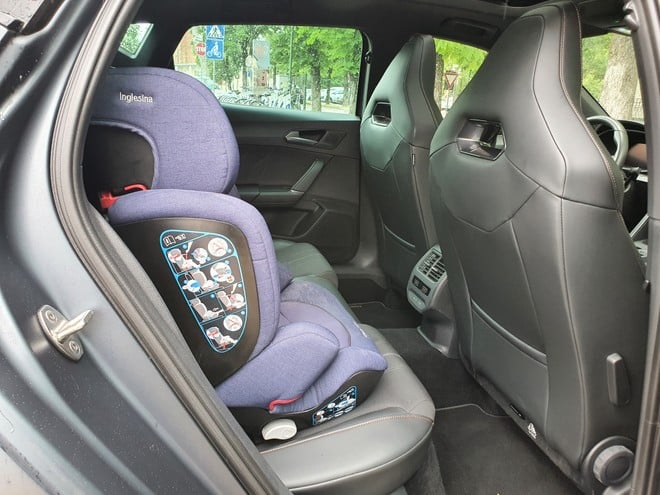
Little is said about it but for families who have a child, being able to easily install a car seat is a must. important. We therefore did this little test on the Cupra Leon. There are "drowned" Isofix attachments behind. in the seats. Personally I prefer the "small boxes with a flap". You open them and you immediately see the attachments to attach the seat to. In any case, on the Leon I didn't struggle to find the slots in which to pass the bars of the seat. Everything is done in a couple of minutes.
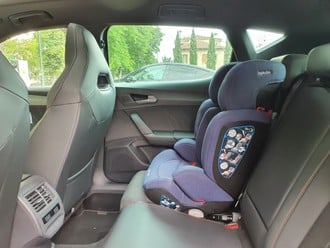
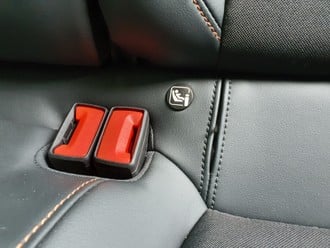
The rear door then opens enough to let a child seat of a 6-year-old girl pass through without having to perform any particular manoeuvres. Once on board and seated in the seat, a minor of about 120 cm in height has enough space to be comfortable. Before leaving, parents can then adjust the air conditioning flow from the rear vent to improve their child's comfort during the journey.
ENGINE AND SAFETY 

The Cupra Leon e-HYBRID DSG is the newest model in the world. equipped with a powertrain consisting of a 4-cylinder 1.4 turbo petrol engine combined with a unit; electric. Overall, 180 kW (245 HP) is available with 400 Nm of torque. The change is a 6-speed DSG automatic. The car manufacturer declares a speed; maximum speed of 225 km/h and acceleration from 0 to 100 km/h in 6.7 seconds.
The electric propulsion is powered by a 12.8 kWh battery capable to offer a range of 55-60 kmaccording to the WLTP cycle. Consumption equal to 1.2-1.3 litres/100 km (WLTP) and emissions equal to 20-30 g/km of CO2 (WLTP). The accumulator can be recharged in alternating current up to a maximum power of 3.6 kW. From a public toll station, it takes about 3 hours and 33 minutes for a full supply of energy (0-100%).
On the front of the driving assistance systems, the Cupra Leon can be better off. have, for example, the Travel Assist, the Side Assit and the road sign recognition system.
ROAD TEST 
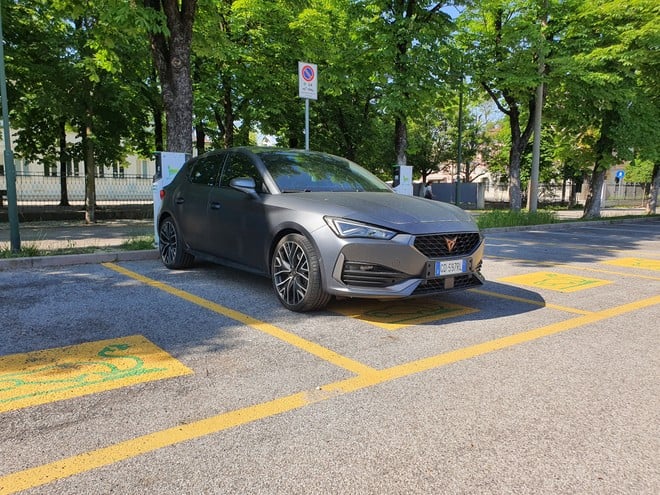
Finding the right riding position isn't easy. a problem even if you exceed 180 cm in height. The space there is; And the sporty bucket seats with integrated headrests were a nice surprise, as they offer a good level of comfort even on motorway journeys. The powertrain pushes really well. Selecting the mode Sport or, even better, the mode; Cupra, the 245 HP available is felt by everyone, and the car becomes really fun to drive. Attention only that with the mode; Cupra, the battery level drops rapidly, this is because; the electric motor offers the maximum contribution to the endothermic one to ensure maximum performance.
Cupra has done a good job on the set-up. Cornering is fun and even exaggerating a bit electronics are ready to intervene, making driving safe at all times. The brakes are very good, always ready to intervene even in the event of emergency braking. Thanks to the different modalities; of driving is; possible "transform" the character of the Leon that can; "trot" calm or become a true sportswoman able to offer burning accelerations. We remind you that the car & egrave; equipped with MacPherson at the front and multilink at the rear.
The 6-speed DSG gearbox is also good, always very precise when changing gears. For my taste maybe a little bit too much. slow in mode; Comfort when accelerating hard. I remember that the modalities; driving characteristics of the Cupra Leon are: Comfort, Sport, Cupra and Individual. And speaking of the gearbox, there would also be paddles behind the steering wheel which, however, are perhaps a bit more complicated. little ones.
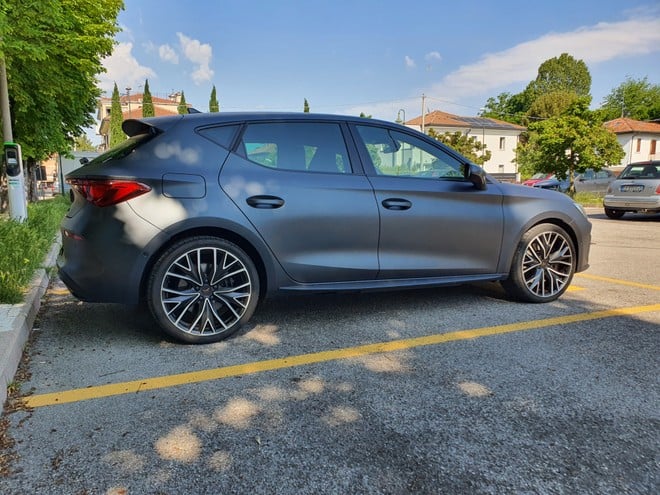
On the highway, at speed code, comfort is; Good. Soundproofing is not included. not bad at all and the aerodynamic hisses are contained. With the Cupra Leon you have fun but you can; also traveling without problems also thanks to the ADAS that work well.
A small hint about using the car in standby mode. 100% electric. The unit is from 85 kW (115 HP) allows you to move with ease in traffic and also on the highway. Obviously you shouldn't expect great performance when you insist on the accelerator. After all, the modality electric only & egrave; designed primarily for the city; and short transfers at a leisurely pace. We'll talk about the effective range later.
Like all Plug-ins, the Cupra Leon offers its best when the battery is low. always charged. For this reason, if you plan to buy it, it is the best choice. it is essential to be able to recharge it at home or at work or to have a column near your home. With the accumulator discharged, the contribution of the electric motor is obviously drastically reduced, making driving less fun and leading to an increase in consumption.
ELECTRIC AUTONOMY AND CONSUMPTION 

So, how many km does the Cupra Leon travel e-Hybrid DSG full of energy? We have covered exactly 51 km. It must be said that in this test, the outside temperature was around 16 degrees and it is not the same. air conditioning was used. The route consisted of 30% urban roads and 70% suburban roads.
A result, therefore, slightly below what was declared by the car manufacturer. For statistical purposes, at the end of the recharge session, to go from 1% to 100% of the accumulator charge, the column manager's app reported 11 kWh supplied. Net of dispersions, it means that the battery has recharged about 10 kWh effective or a little more.
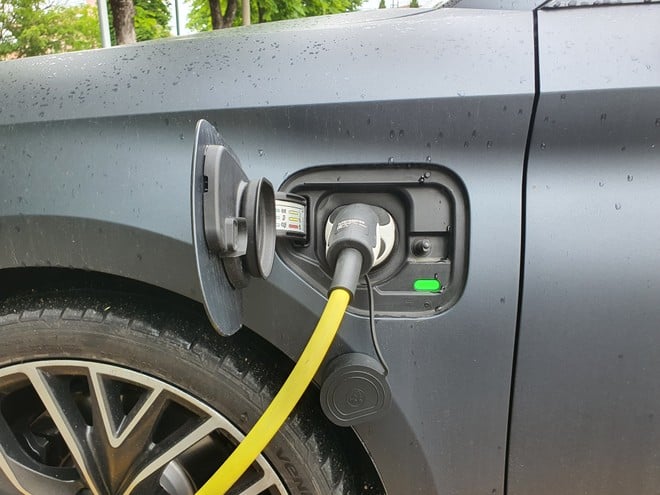
Now let's talk about the consumption measured using the car in normal mode. hybrid. First, we carried out a test on a route of about 55 km, with few towns and cities. and the rest on extra-urban roads. Outside temperature 25 degrees, climate control set to 22.5 degrees, battery full and mode on. driving comfort. In this context, consumption was 3.1 liters per 100 km. It must be said that on a similar route, in mode; hybrid and with the battery charged, the internal combustion engine tends to be used as little as possible. At low speeds, almost exclusively the electric one works. The endothermic intervenes in the acceleration phases (especially if you insist a little) and at higher speeds. more elevated. However, when traveling at high speeds, constant (even between 60 and 80 km/h), the endothermic is switched off and the car continues to travel in electric only.
We then carried out a more difficult test. demanding on a route of 137 km of which about 110 km on the motorway. Always Mode Hybrid activated, battery charged, temperature 26 degrees and climate control set to 22.5 degrees. The result? The car covered this journey with a consumption of 4.7 liters per 100 km. Obviously, on the motorway the internal combustion engine always remains in operation with the contribution of the electric one which is greatly reduced. At the end of the trip, the battery still had 40% of the charge.
But what happens if we run out of battery charge? How much does the car consume in normal mode? hybrid but with the contribution of the electric motor reduced to zero or almost? We were able to carry out this test when picking up the car at the end of a press event. It hadn't been possible to top up and therefore the car crashed. Delivered with 1% battery charge. After a journey of 325 km, of which 300 km on the motorway (outside temperature between 18 and 22 degrees and climate control set at 23.5 degrees), fuel consumption has dropped to 300 km. certified at 6.2 liters per 100 km.
TECHNICAL SHEET 

- Engine: 4-cylinder 1.4-litre turbo (150 HP) + electric (115 HP)
- Power: 188 kW/245 HP with 400 Nm of torque
- Gearbox: 6-speed DSG automatic
- 0-100 km/h: 6.7 seconds
- Speed & maximum: 225 km/h
- Battery: 12.8 kWh
- Front suspension: independent McPherson, coil springs and hydraulic shock absorbers
- Rear suspension: multi-link axle, coil springs and hydraulic shock absorbers
- Tyres: 235/35 R19
- Brakes : front and rear with ventilated discs
- Weight in o. d. m.: 1,660 kg
- Boot: 270 litres
- Length: 4,398 mm
- Height: 1,467 mm
- Wheelbase: 2,682 mm< /li>
- Skills petrol tank: 40 litres
- Declared range in electric mode (WLTP): 55-60 km
- Declared fuel consumption (WLTP ): 1.2-1.3 l/100 km
- Declared CO2 Emissions (WLTP): 28-30 g/km CO2
< li>Width: 1,799 mm
PRICES 
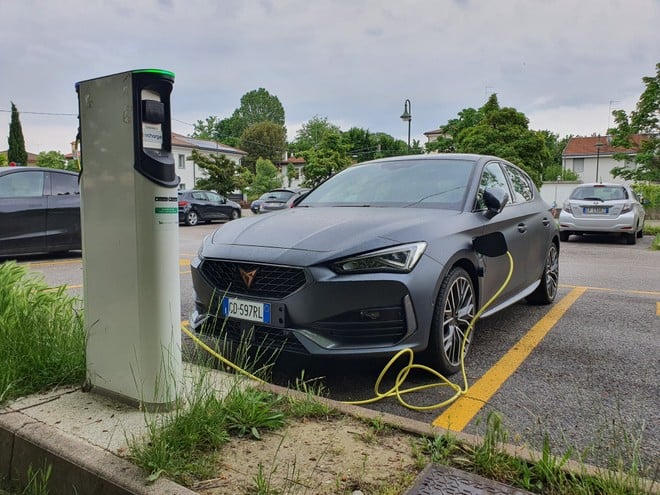 < p>In Italy, the Cupra Leon is; offer with unit; petrol and diesel. In addition, Plug-in versions are also available. Specifically, customers will be able to choose between a 150 HP 1.5 TSI petrol engine, a 190 HP 2.0 TSI DSG petrol engine, a 150 HP 1.5 Hybrid DSG (Mild Hybrid), a 204 HP 1.4 e-Hybrid DSG (Plug-in) HP and a 150 HP 2.0 TDI diesel, also with DSG gearbox.
< p>In Italy, the Cupra Leon is; offer with unit; petrol and diesel. In addition, Plug-in versions are also available. Specifically, customers will be able to choose between a 150 HP 1.5 TSI petrol engine, a 190 HP 2.0 TSI DSG petrol engine, a 150 HP 1.5 Hybrid DSG (Mild Hybrid), a 204 HP 1.4 e-Hybrid DSG (Plug-in) HP and a 150 HP 2.0 TDI diesel, also with DSG gearbox.
The most powerful; performing Cupra Leon VZ you can; have with a 300 HP 2.0 TSI DSG petrol and a 245 HP 1.4 e-Hybrid DSG (Plug-in). Same engines for the most; exclusive Leon VZ Carbon. How much does the Cupra Leon cost in Italy? Prices start at 32,350 euros for the 150 bhp Leon 1.5 TSI. Below, we report the complete price list of this model by the Spanish manufacturer.
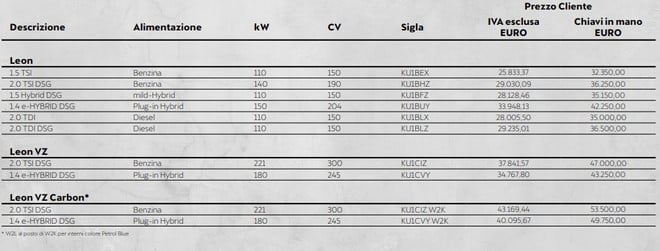
CUPRA LEON ONLINE CONFIGURATOR
Limited budget? Redmi Note 12 4G, buy it at the best price from eBay at 154 euros.